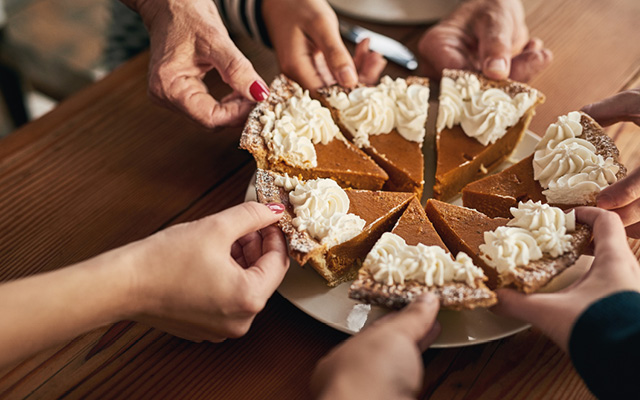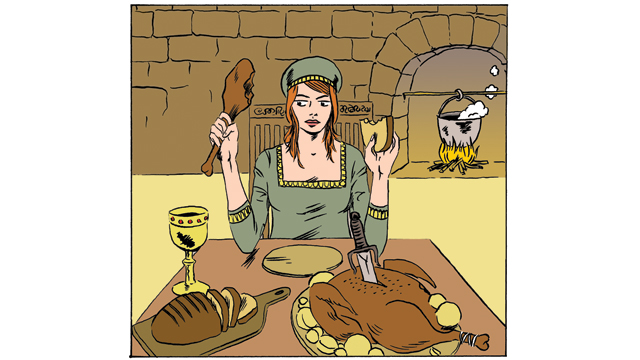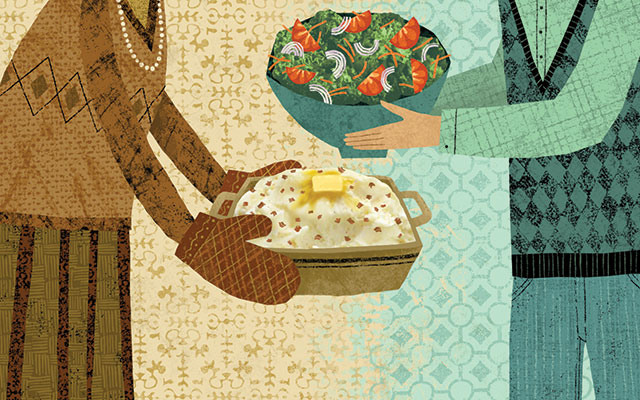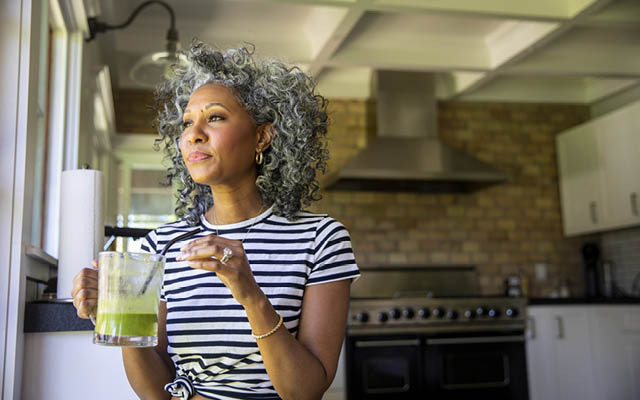My Grandma Millie was a fighter, a survivor, a great American success story, and a really god-awful cook.
She was born in London in 1905, the green-eyed, redheaded daughter of Jewish refugees who had moved there after fleeing the pogroms in the farmland outside Minsk. Her Yiddish-speaking family eventually made it to America, where she grew up in the East New York ghetto and dropped out of school in the second grade to take a job sorting buttons in a shoe factory. By the time she reached her 20s she had met my grandfather, a feisty orphan plumber, and had enough of life on the factory floor.
When Millie left the shoe factory, the girls she worked with presented her with an engraved loving cup made of chrome. She kept this memento on the sideboard next to the dining room table for the rest of her life. A dining room table that saw the raising of four children, all of whom went to college, and all of whom left the nest fueled on a diet of things cooked in the morning and then kept in a 200 degree oven for the rest of the day — until each dish’s various components had separated out into layers. Grease on top, mushy proteins in the middle, and bone and sediment crusting to the bottom.
Her roast chicken, cut into segments and layered into a Pyrex pan, was served with a spoon, which was not a good thing. So were the Aunt Jemima carrots, coated with pancake syrup and raisins and baked until, well, you can imagine.
Grandma loved to get boxed cake mixes and doctor them up with grocery-store extracts and food coloring. I remember one cake in particular that had a cinnamon-extract crumb layer topped with a thick, flamingo-pink mixture of Jell-O and cream cheese. She wouldn’t eat these things herself. (But did you want seconds?) Instead, she indulged her taste buds with grocery-store cookies, especially Mallomars, a graham-cracker disc surmounted by marshmallow and enrobed in fudge. She liked to dip these in sugary Lipton tea, a habit she attributed to her several-months-long British upbringing.
Millie died years ago at the age of 96, and I — grandchild number four, eldest of her youngest — have gone on to a starry gastronomic existence: sipping vintage champagne, eating in four-star restaurants, plating my grass-fed lamb on a bed of healthful quinoa. And I would pay all the money I have for a scoop of stratified chicken with my grandma or one of her beloved Mallomars soaked in sugary corporate tea.
That’s the great contradiction of life, isn’t it? You really shouldn’t have that Nabisco cookie with Grandma Millie. You shouldn’t have that deep-dish pizza with your brother when you visit Chicago. But life is short. You could be eaten by a lion next week. In which case, you think to yourself, Why not go home for the holidays and indulge in a couple pieces of Mom’s fried chicken and a slice or two of Aunt Judy’s shoofly pie?
Then again, if you eat every crazy thing that floats past, life really will be short — and uncomfortable.
So what to do? How do you balance healthful eating and emotional indulgence? Well, first let me say a few words in defense of emotional indulgence, a concept I believe is unfairly maligned.
Our emotions and the memories we associate with them are real. They motivate us, and give us the strength to tackle tough situations and to love more deeply. They comfort us in the dark of night and sustain us during life’s long journey.
There are some people on that journey who unfailingly treat themselves like fine European racing cars: high-quality fuel in, pure performance out. For the rest of us who associate food and dining with family, friends and memory, however, that’s a recipe for loneliness and failure.
So let’s rephrase the question: How do you manage emotional indulgence in a healthy way?
Well, friend, I humbly suggest you think about pain. No, really. You know that zero to 10 pain chart you get in the hospital? Think about food in those terms. It immediately helps solve a dilemma especially common during the holidays, namely, the constant unanswerable question: Is it worth it?
At zero, certain foods — a bag of powdered sugar, for instance — are worthless. They have no nutritional value and carry no emotional punch. If you go to the company Christmas party and a greeter at the door offers to hook a feedbag of powdered sugar over your ears, you can quickly decide: On a scale of zero to 10, I give this a zero.
But wait. In some cases there might be a certain amount of social pressure. For instance, your boss might really value people who put on the powdered-sugar feedbag. In that case, I might give it a two. If you have a tablespoon or three of sweetness, the physical toll will be somewhat noticeable, but it might make you feel better about asking your boss for that much deserved raise. So you strap on the feedbag and then ditch it in a corner as soon as possible.
You might give that cheesy pizza with your brother a six or seven, both because the ingredients (while heavy on gluten and dairy, and laden with refined carbs) are mostly fresh — and the dining experience so much fun.
Sugar cookies at the in-laws might rate a four. As for my grandma’s Jell-O cake? That gets a nine or 10, no matter the day.
You get the picture. In between these pain-scale judging moments, I suggest you strive to consume as many healthy, noncelebratory meals as you can. A fluffy breakfast omelet with spinach will do wonders to keep you on track during a holiday lunch, and crudités, in my humble opinion, are better than a plum pudding throughout holiday party season.
Of course, crudités are nothing but a fancy French way of saying raw or blanched vegetables, but a crunchy snack of veggies in the afternoon can make all the difference between emotionally rewarding eating and the self-loathing that descends when you work through lunch and then eat the entire tray of undercooked brownies that Charlene from Accounting left in the office kitchen.
Of course, for a lot of us, Thanksgiving or Christmas Eve or the first night of Hanukkah, Kwanzaa and other like-sized holidays are 10s right off the bat. So, if you look at your month and see nothing but compromises every night, make another pass and see if you can find a day or two that might be negotiable. If you can’t, my best advice is to go in fortified with plenty of sleep, exercise and some crudités, and try to enjoy yourself. The worst that can happen is that you fail, in which case you pick yourself up and try again.
As Nelson Mandela said, “Do not judge me by my successes; judge me by how many times I fell down and got back up again.”
Is it insane to bring freedom fighter Nelson Mandela into a discussion of Mallomars and holiday eating? Of course it is. It’s absurd. But life is absurd. It starts out fleeing Minsk and ends up surrounded by grandchildren. It involves work meetings that run too long and pans of undercooked brownies. And it’s even crazier during the holidays.
But what sometimes makes this time of year hard to navigate is also what makes it so memorable: friends, family and the ones you love. The people who bake those brownies, who serve up scoopfuls of chicken from a Pyrex pan and who never stop thinking of you while they’re doing it. The people who define the difference between a life and a life deeply felt.




This Post Has 0 Comments